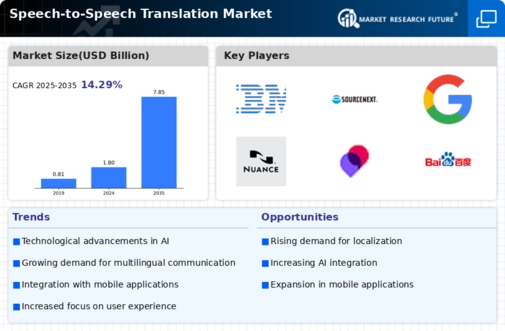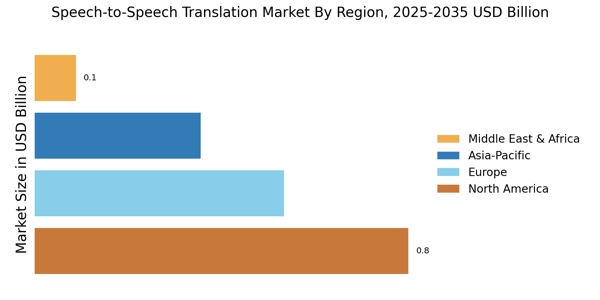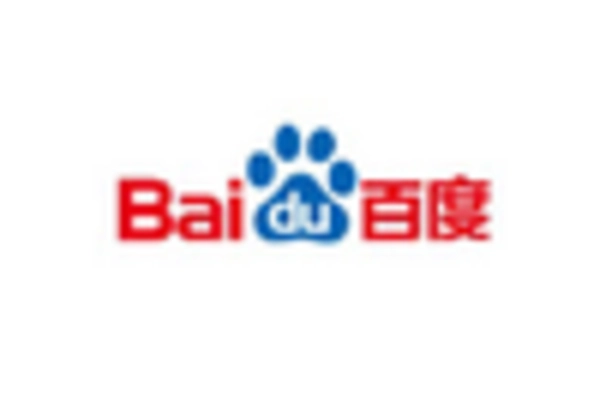Rising Global Mobility and Travel
The Speech-to-Speech Translation Market is likely to see substantial growth due to the rising trend of global mobility and travel. As individuals increasingly travel for business or leisure, the demand for effective communication tools that can bridge language gaps becomes paramount. The market data indicates that international tourist arrivals have been steadily increasing, with millions of travelers seeking services that facilitate smooth interactions in foreign countries. This trend underscores the necessity for reliable speech translation solutions that can operate in real-time, thereby enhancing the travel experience. Furthermore, the Speech-to-Speech Translation Market is expected to expand as travel agencies and hospitality services integrate these technologies into their offerings, catering to a diverse clientele and improving customer satisfaction.
Advancements in Natural Language Processing
The Speech-to-Speech Translation Market is experiencing a surge in advancements in natural language processing (NLP) technologies. These innovations enhance the accuracy and efficiency of translation systems, allowing for more nuanced and context-aware translations. As NLP algorithms become increasingly sophisticated, they enable real-time translation capabilities that are essential for effective communication in diverse settings. The market is projected to grow significantly, with estimates suggesting a compound annual growth rate (CAGR) of over 20% in the coming years. This growth is driven by the need for seamless communication across language barriers, particularly in business, travel, and diplomatic contexts. Consequently, the Speech-to-Speech Translation Market is poised to benefit from these technological advancements, which may lead to broader adoption and integration into various applications.
Emergence of Smart Devices and Applications
The Speech-to-Speech Translation Market is poised for growth due to the emergence of smart devices and applications that incorporate speech translation capabilities. With the proliferation of smartphones, tablets, and smart home devices, consumers are increasingly seeking solutions that enable effortless communication across languages. Market trends indicate that the demand for mobile applications featuring speech translation functionalities is on the rise, as users prioritize convenience and accessibility. This shift is further supported by advancements in artificial intelligence and machine learning, which enhance the performance of translation applications. As a result, the Speech-to-Speech Translation Market is likely to expand, driven by the integration of these technologies into everyday devices, thereby making speech translation more accessible to a broader audience.
Integration of Speech Translation in Education
The Speech-to-Speech Translation Market is experiencing a transformative shift with the integration of speech translation technologies in educational settings. As educational institutions increasingly adopt digital tools to enhance learning experiences, the demand for translation solutions that support multilingual classrooms is on the rise. This trend is particularly relevant in regions with diverse student populations, where effective communication is crucial for academic success. Market data indicates that educational technology investments are projected to grow significantly, with speech translation tools playing a pivotal role in facilitating inclusive learning environments. Consequently, the Speech-to-Speech Translation Market is likely to benefit from this trend, as schools and universities seek to implement technologies that promote language learning and cross-cultural understanding.
Increased Focus on Cross-Cultural Communication
The Speech-to-Speech Translation Market is witnessing a heightened focus on cross-cultural communication, driven by globalization and the interconnectedness of societies. Organizations are increasingly recognizing the importance of effective communication in fostering collaboration and understanding among diverse teams. This trend is reflected in the growing investment in translation technologies that facilitate real-time speech translation, enabling seamless interactions across different languages. Market analysis suggests that companies are prioritizing tools that enhance employee engagement and customer relations in multicultural environments. As a result, the Speech-to-Speech Translation Market is likely to expand, with businesses seeking solutions that not only translate words but also convey cultural nuances, thereby improving overall communication effectiveness.


















Leave a Comment